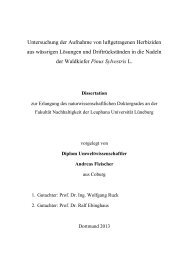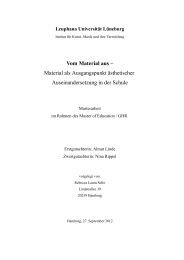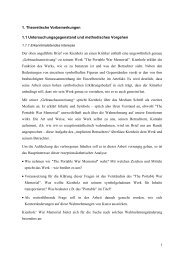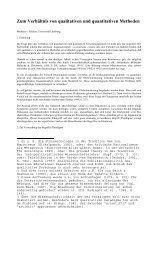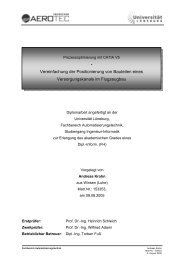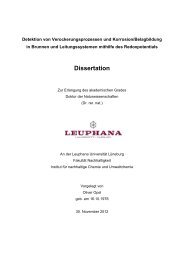Determinants of Emotional Experiences in Traffic Situations ... - OPUS
Determinants of Emotional Experiences in Traffic Situations ... - OPUS
Determinants of Emotional Experiences in Traffic Situations ... - OPUS
Create successful ePaper yourself
Turn your PDF publications into a flip-book with our unique Google optimized e-Paper software.
127 General Conclusion<br />
impact is similar with anger (higher velocity, more speed<strong>in</strong>g and stronger lateral accelerations). Fright<br />
appears to be a highly adaptive emotion, lead<strong>in</strong>g to immediate reductions <strong>in</strong> velocity and stronger<br />
brak<strong>in</strong>g but also more weav<strong>in</strong>g (supposedly an attempt to dash the obstacle). No accidents occurred<br />
dur<strong>in</strong>g the experiment (the forgiv<strong>in</strong>g track design promoted safety), although common sense suggests<br />
that driv<strong>in</strong>g at higher speeds is more dangerous than driv<strong>in</strong>g carefully. The split between short and<br />
long-term effects poses new questions for the doma<strong>in</strong>:<br />
• Which emotions are effective immediately after an emotional event (such as fright)?<br />
• Which emotions unfold their impact later – even after kilometres <strong>of</strong> driv<strong>in</strong>g – (such as<br />
anxiety)?<br />
• Is there a change <strong>in</strong> the <strong>in</strong>fluence <strong>of</strong> cognitive mechanisms over time (e.g., first riskperception<br />
followed by selective attention or vice versa)?<br />
• At what threshold <strong>of</strong> emotion and under what situational circumstances is the possibility <strong>of</strong> an<br />
MVA greatly enhanced?<br />
3. Specific groups <strong>of</strong> drivers are prone to driv<strong>in</strong>g faster and more aggressively; yet this propensity is<br />
due only partly to the (stronger) emotional responses observed <strong>in</strong> that specific group. The personal<br />
characteristics at the centre <strong>of</strong> attention were gender (especially males) and persons with a high<br />
driv<strong>in</strong>g motivation (e.g., those who <strong>in</strong>corporated driv<strong>in</strong>g <strong>in</strong> their daily lives). They tended to show<br />
more overt risky driv<strong>in</strong>g behaviours, <strong>in</strong>clud<strong>in</strong>g driv<strong>in</strong>g at higher speeds with stronger (lateral)<br />
accelerations. These effects were partly mediated by stronger experienced anger, but there was also a<br />
standalone impact. Therefore, a specific group <strong>of</strong> people on the road may experience a ‘double dip’ <strong>in</strong><br />
driv<strong>in</strong>g performance decl<strong>in</strong>e. The first dip is due to personal characteristics (e.g., be<strong>in</strong>g male and<br />
highly motivated), and the second dip is reflective <strong>of</strong> an <strong>in</strong>creased probability to experience (stronger)<br />
anger. This f<strong>in</strong>d<strong>in</strong>g that both personal characteristics and emotions yield similar effects on driv<strong>in</strong>g<br />
behaviour leads to new questions <strong>in</strong> the field.<br />
• To what extent are cognitive processes (risk perception, attention-deployment) <strong>in</strong>fluenced by<br />
emotion and how much variance do personal characteristics expla<strong>in</strong>?<br />
• How are those cognitive processes l<strong>in</strong>ked to driv<strong>in</strong>g behaviour <strong>in</strong> various situations?<br />
• Similar to the second study, at what threshold <strong>of</strong> emotion and under what situational<br />
circumstances is the possibility <strong>of</strong> an MVA greatly enhanced?<br />
• To what extent do the social environment (beyond the blame factor <strong>of</strong> the appraisal<br />
framework) and its variables (identification, evaluation, judgement and criticism) <strong>in</strong>fluence<br />
emotion elicitation and expression <strong>in</strong> traffic situations and how is this <strong>in</strong>fluence related to<br />
personal characteristics such as fear <strong>of</strong> evaluation or type A behaviour?<br />
These questions are await<strong>in</strong>g further research <strong>in</strong> traffic psychology, and to accomplish this, they must<br />
be approached with multiple methodologies. This <strong>in</strong>cludes simulated and real driv<strong>in</strong>g experiments,<br />
which could connect emotions and <strong>in</strong>fluenced cognitive processes to subsequent driv<strong>in</strong>g behaviour.<br />
!



